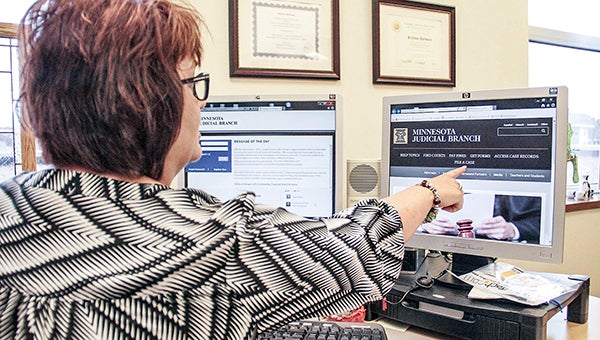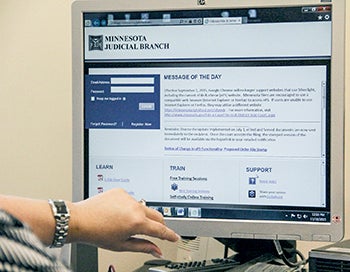Courts take a step toward paperless; Online filing opens to lawyers, public
Published 10:55 am Monday, November 23, 2015

Court Administrator Krissy Bartness demonstrates where the public can go on the Minnesota Courts website, www.mncourts.gov, to electronically file a case. — Jason Schoonover/jason.schoonover@austindailyherald.com
The push for Minnesota counties to transition toward paperless courts took another step forward earlier this month.
More than 24 district courts across southern Minnesota, including Mower County, are now offering court users the ability to electronically file and serve court documents through an online portal.
“I would encourage anyone looking to try it to utilize it,” Mower County Court Administrator Krissy Bartness said. “They will find it beneficial and an easier way to get access to their documents and get their filings into the court.”
The move to electronic filing and service of case documents — known as eFiling and eService, which is often called EFS — is part of the Minnesota Judicial Branch’s eCourtMN initiative to transform the state’s court system by replacing paper-based court files with an electronic information environment.
This latest step means that now lawyers and the public can file cases from their own homes or offices at www.mncourts.gov by clicking “File a Case” and following the instructions.
The electronic filing service will mostly affect civil/family cases and conciliation court cases.
Most criminal cases will continue coming through law enforcement, which is a different type of filing system. Supplemental documents after initial criminal cases can also be electronically filed by the prosecutor or defense attorney.

Court Administrator Krissy Bartness pulls up the wbsite where the public can go on the Minnesota Courts website, www.mncourts.gov, to electronically file a case.
Though people are still learning and getting used to the new system, Bartness sees e-filings increasing and expects them to increase as the word gets out about the benefits and the ease.
“The thing with EFS is you can file any time day or night,” Bartness said. “So that’s a convenience. You can be at home and not worry about having to get to the court house before it closes at 4:30 to file your papers.”
The site walks residents through how to file a case, and Bartness and McCormack described it as user-friendly, as there are even web trainings to show people how to use the site. The only two things people need are a computer and a debit or credit card.
Court Operations Supervisor Aimee McCormack Aimee and Bartness compared the electronic filing services to the ability to pay traffic tickets now online or shop on Amazon — people just expect instant, 24/7 access to key services through the Internet.
“That’s really what people look for,” Bartness said.
The transition to electronic court filings has been going on a few years, and Bartness said it’s gone smooth thus far since district courts leaders did a good job of preparing. However, the electronic system makes for a significant change.
“It was a big transition of workflow and how we handle the incoming documents and papers and filings, so that was a major transition for us,” Bartness said.
For roughly a year of transition time, court administration would take submitted paper documents and scang them so they had electronic files for judges and staff to review. A big part of that was getting people to grasp the concept of not having the paper copies.
“What it basically was was preparing us to work in a paperless world,” McCormack said.
Many groups like law firms, the county and city attorneys offices, probation officers, human services and other government partners are still in the process of converting over.
Electronic filings will be mandatory for those groups on July 1, 2016.
The goal of the eCourtMN initiative – which received a 2014 State Government Innovation Award from the University of Minnesota’s Humphrey School of Public Affairs – is to make the state’s court system more accessible, more efficient, and more convenient for court customers.





